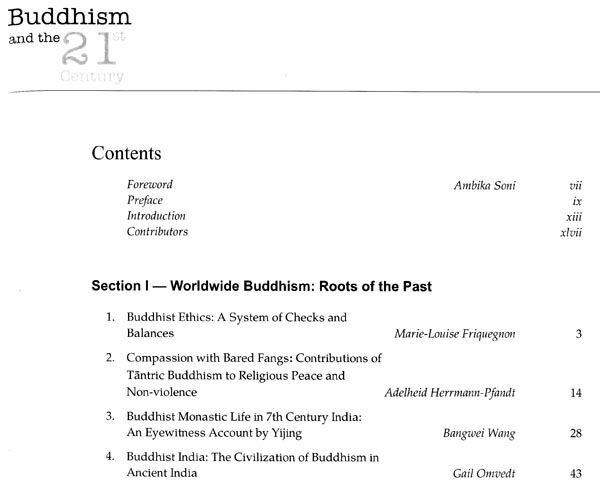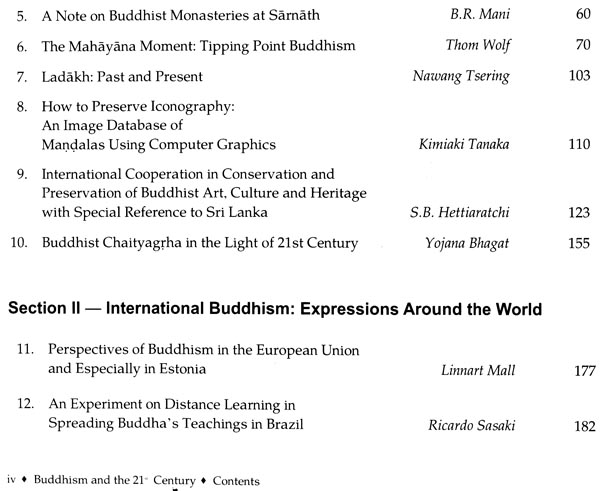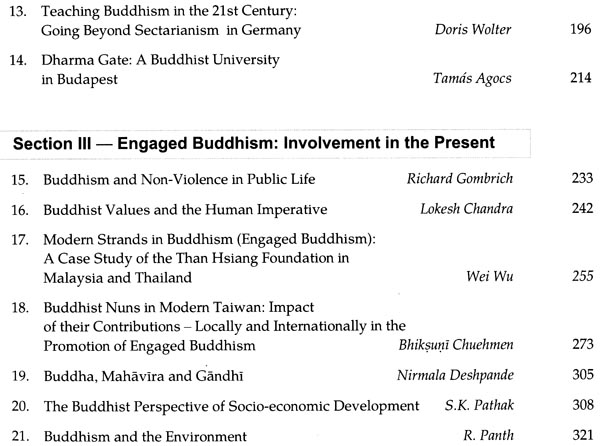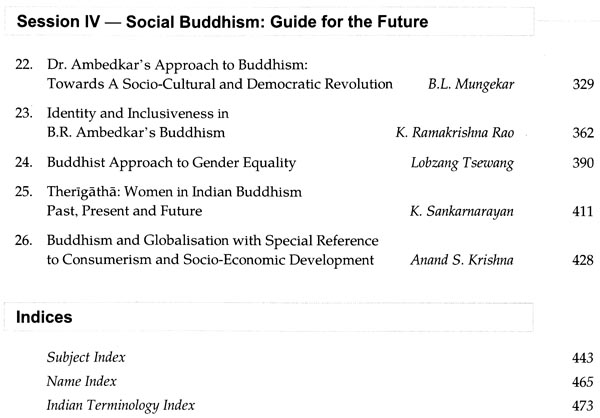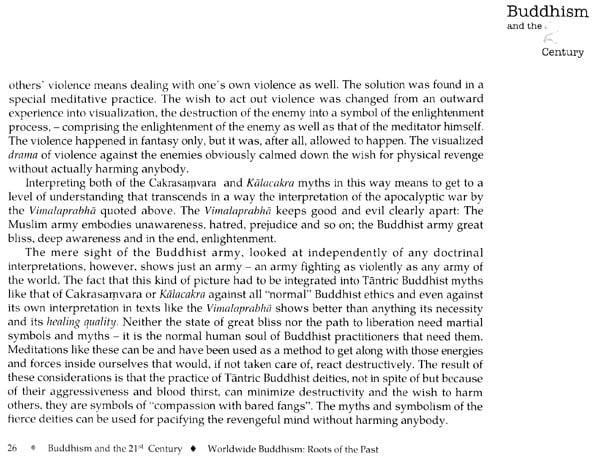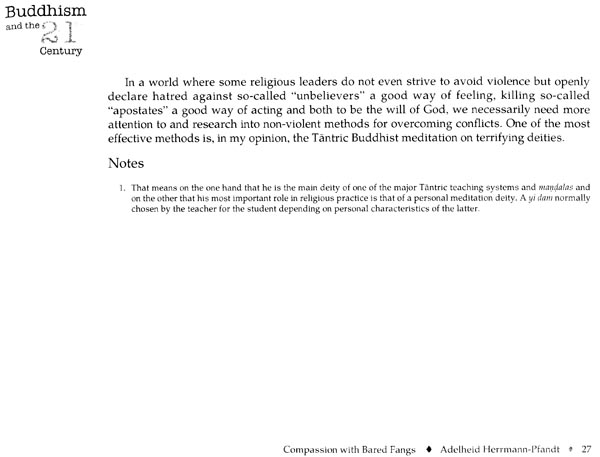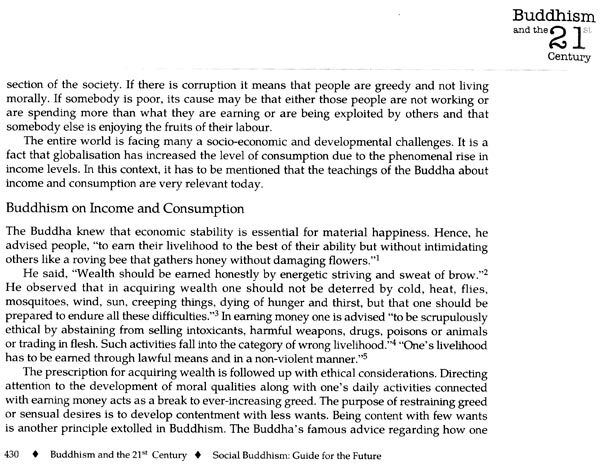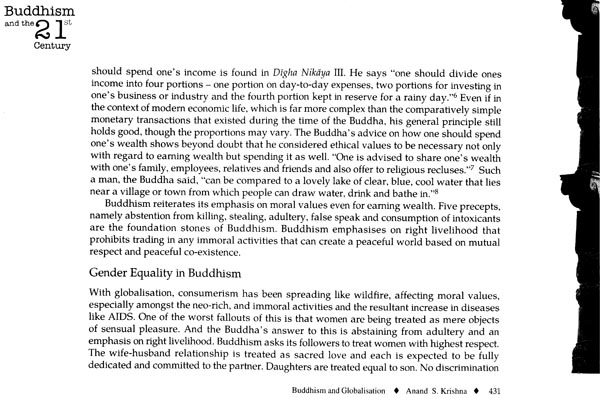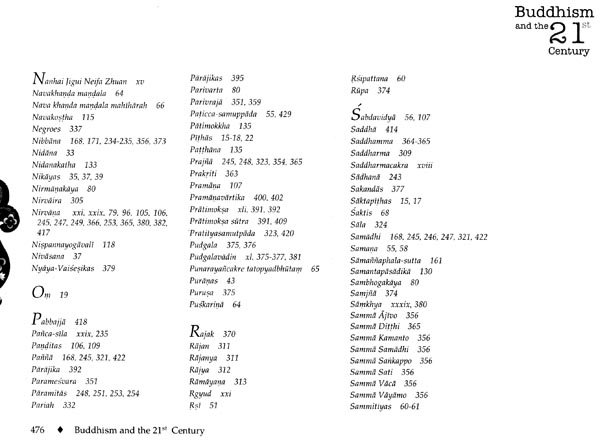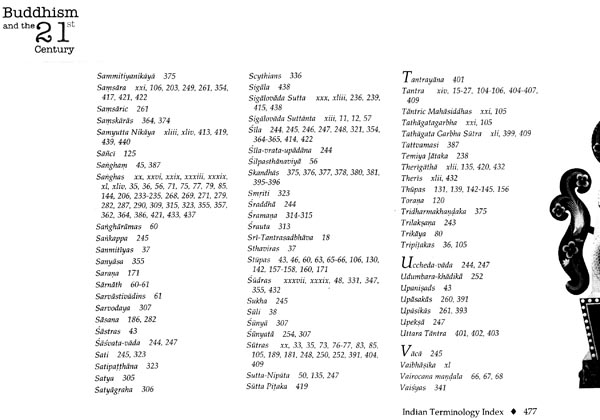
Buddhism and The 21st Century - Commemoration of the 2550th Anniversary the Mahaparinirvana of Lord Buddha
Book Specification
| Item Code: | NAX985 |
| Author: | B.L. Mungekar |
| Publisher: | Nava Nalanda Mahavihara, Bihar |
| Language: | English |
| Edition: | 2009 |
| ISBN: | 9788188242177 |
| Pages: | 532 (Throughout Color and B/w Illustrations) |
| Cover: | HARDCOVER |
| Other Details | 9.00 X 12.50 inch |
| Weight | 3.15 kg |
Book Description
Buddhism and the 21st Century is
A literary experience - your opportunity to be there through the Conference writers
from all over India and from Brazil. China. Estonia. Germany. Hungary. Japan. Malaysia. Sri Lanka. Taiwan. Thailand. UK and USA
An intellectual challenge - an exposure to the fermenting discussion in the 2550th year
from the millennium of Buddhist India. the tipping point of Mahayana Buddhism and the compassion of bared fangs Tantric Buddhism
to Buddhism's contemporary political voice. issues of gender equality. and the relevance of liberty. equality and fraternity in Dr. B. R. Ambedkars socially engaged Buddhism
An artistic expression - a never-before collection of beauty and imagination
via historical icons. sensitive images. and evocative creativity on every page
A spiritual testimony - voices of Buddhism
from the landmark individuals of Queen Mahaprajapati, Asoka, Asvaghosa and Eshes Old
to the contemporary devotees in the Americas. Europe. Taiwan. China. South East Asia and South Asia
Buddhism and the 21st Century. a veritable literary
encyclopedia on Buddhism, gives a comprehensive and intensive treatment to the issues of peace, non-violence, co- operative life and individual enlightenment relevant to the contemporary world from the Lord Buddha's perspective.
· Professor of Industrial Economics, Center of Advanced Study, University of Mumbai
· Founder-President, Dr. Ambedkar institute of Social and Economic Change
· Member, Commission for Agricultural Costs and Prices, Government of India
· Invited Guest, People’s Republic of China by the Chinese Academy of Social Sciences
Founder several academic and social institutions, Dr. Mungekar has been honored with academic, economic, and social awards in recognition of his distinction in academic and social services across India including D.Lit. and Bharat Ratna Dr. Babasaheb Ambedkar Award.
I am happy to have this opportunity to commend the contributions to this volume by eminent scholars. They have given the reader, a World view from the eyes of those who follow the values enunciated Lord Buddha.
Gaya Conference, and Member, Plan Government of India for the organization attended by so many distinguished people, getting this volume published.
The Ministry of Culture, Government of India was entrusted with the implementation of the various activities that were planned. Smt Ambika Soni, Humble Minister of Tourism & Culture, was the Vice Chairperson of the National Committee and also was the Chairperson of the Implementation Committee which constituted three Sub-Groups for finalizing and coordinating these activities.
The year-long programmers were inaugurated by the Humble Prime Minister on 13th May, 2006 (Buddha Purnima Day) in New Delhi which was attended by many important socio-political and religious leaders. Several seminars, workshops and cultural programmers were organized in different parts of the country throughout the years. The closing ceremony was held at Kushinagar (the place of Mahaparinirvajla) on 2nd May, 2007 (Buddha Purnima Day).
As a part of the commemoration activities, a three-day International Conference on Buddhism and the 21st Century held at Bodhgaya from February 4th to 6th, 2007 was an important academic national event. Since the objective of the conference was to examine and analyze the challenges facing the 21st century from the point of view of the Buddha's philosophical perspective, the main theme of the Conference was divided under the following sub-themes:
sub-themes:
1. Buddhism in India: Past, Present and Future
2. International Practices in Buddhism
3. Buddhism and the West Modern Strands in Buddhism (Engaged Buddhism, Buddhism as Composite Culture, etc.)
4. Compassion and Non-violence: Buddha, Mahavira and Gandhi (Role of Buddhism in Combating War, Violence and Terrorism) 5. Buddhist Perspective of Socio-economic Development (Consumerism, Globalization, etc.) 6. Buddhist Approach to Gender Equality 7. Creating a Casteless Society: Dr. B.R. Ambedkar's Contributions to Buddhism 8. Buddhist Approach to Ecology and Environmental Crisis 9. Conservation and Preservation of Buddhist Art, Culture and Heritage It was indeed gratifying that despite the time constraint we could succeed in getting international scholars from as many as 12 countries, tnz., Brazil, China, Estonia, Germany, Hungary, Japan, Malaysia, Sri Lanka, Taiwan, Thailand, UK and USA to present papers at the conference. Besides, there were eminent scholars from various parts of India who also contributed their papers. I am grateful to all contributors, particularly foreign scholars, who promptly responded to our request.
Section I - Worldwide Buddhism: Roots of the Past
Chapter 1 Marie-Louise Friquegnon of William Patterson University is refreshing, blunt, and helpful in "Buddhist Ethics: A System of Checks and Balances". According to Friquegnon, Buddhist ethics is a synthesis of three types of ethical theories (deontology, rule utilitarianism, and virtue ethics), an ethic that can support some aspects of multi- cultureless without supporting cruel practices, "a compromise between rule-following and concern with consequences in terms of human suffering and happiness, a compromise achieved by means of an ethics of virtue".
The Sigalooada Suttanta holds the essence of Buddhist social ethics in a "scant three pages" where the Buddha "outlines an entire plan for society" by the "reciprocity criterion". Noting contrasts with Hindu ethics in the laws of Manu, Friquegnon draws attention to areas for exploration, reminding us bluntly that over the last 2,550 years, "justice is conspicuously absent in the list of Buddhist virtues". Thus, the turbulent future must continue to seek for a global ethic where "compassion and loving kindness ... are ultimately the wellspring from which any truly moral conduct must emerge". In brief space, Friquegnon is refreshing, blunt, and helpful.
Chapter 2 In chapter two, University of Marburg's Professor of Religion, Adelphi Herananan-Pandit, by two well-chosen examples, steers us from the global heights of philosophical speculations to the local depths of mythic manifestations: the world of Nobel Peace Prize winner Dalai Lama and Tibetan Tantric Buddhism's world of "fierce demons and furious demonesses trampling down their enemies, deadly weapons, steams of blood, corpses, bones and skulls ... the jeweler of raging deities and ... violent sexuality, displayed by ... demonic figures".
"Compassion with Bared Fangs: Contributions of Tantric Buddhism to Religious Peace and Non-Violence" asks, why is the terminology and procedure that of a real war, even though it is only a mythical story? For in the Cakrasamuara-tanira, first it is Hindu males who are killed - trampled underfoot. Then it is Hindu Saivite females who are raped by Buddhist male deities; and finally, the country and every possession is robbed, so that, in the end, it is the memory of the defeated Hindus that will be extinguished forever. Allowing that some "Buddhist and Buddhologists of today try to interpret these images of Buddhists destroying Hindu deities in terms of a pure inner process and reject any connection with the real relationship of Buddhism and Hinduism in India", he probes with the deep question: "If this is the whole truth, why are the deities defeated in the Cakrasamuara myth not painted simply as indeterminate demons and demonesses, e.g., of hatred, craving or ignorance? Why must they be just the same Hindu deities that everyone knew were being loved and adored by the very neighbours and co-citizens of the Buddhist storytellers?"
Book's Contents and Sample Pages
